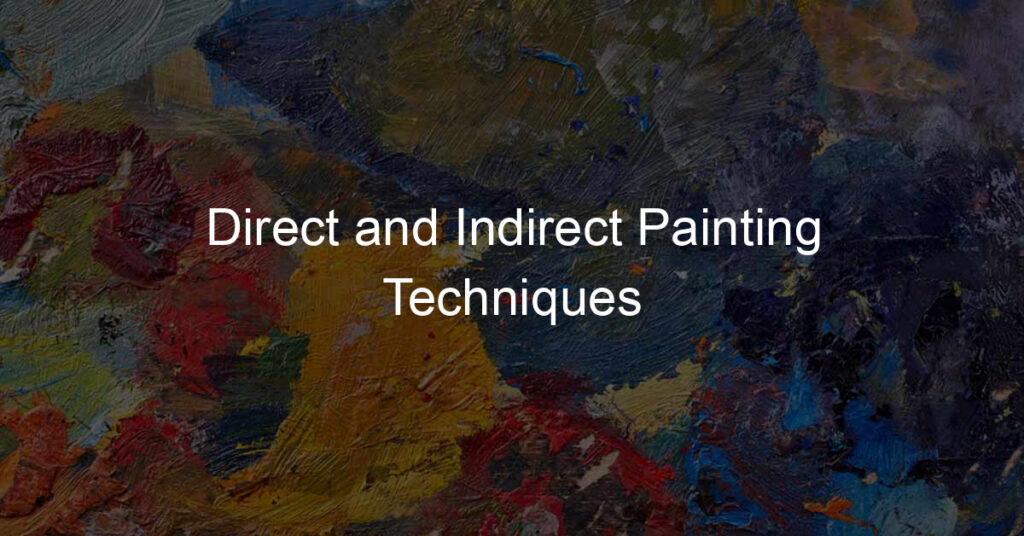Whether you’re a beginner or a seasoned artist, understanding different painting techniques is key to expanding your creativity and developing your style.
In this blog post, we’ll explore two common approaches to painting – direct and indirect.
What are direct painting techniques?
Direct painting techniques refer to a form of artistic expression that is done without the need for additional steps such as drawing, sketching, or outlining.
It’s an approach that involves laying paint directly on a surface with minimal planning. Direct painting can be used by both amateur and professional painters to produce dynamic and creative pieces of artwork.
Many of today’s masterpieces have been crafted using direct painting techniques which showcase the artist’s true capabilities, making it one of the most popular methods among experienced painters.
In addition, direct painting is also increasingly being embraced by aspiring and emerging artists who are looking to explore a fresh technique not only in terms of aesthetics but also for its impact on the intended message.
What is the indirect method of painting?
The indirect method of painting is a style that adds an extra layer of complexity.
Instead of painting directly onto the desired surface, the artist first creates an underpainting with basic colors onto a separate ground.
This initial painting then serves as a base for the artist to add subsequent layers of paint which add depth and texture.
This gradual layering creates interesting effects that can range from complex to subtle.
Experienced painters become adept at this technique and can craft some truly astounding works using indirect methods.
Why is that technique important?
Understanding and using a specific technique can be the key to success in a project, job, or any other endeavor.
It takes time to perfect a technique but once it’s mastered, it can help you reach your goals.
Having the ability to use that technique is important because it gives you an edge over others who don’t have experience with it yet.
Without this knowledge, you risk not having the skills necessary for success.
Furthermore, mastering a technique may also open up more doors of opportunity for future advancements and develop greater self-confidence in your abilities.
Overall, understanding why a specific technique is important is key to unlocking its potential for success.
What is the most basic technique in art?
The most basic technique in art is observation – that is, looking closely and intently at the subject of your artwork and picking out the details.
Whether it’s a landscape painting or a ceramic bowl, artists need to pay attention to the subtleties around them to create visual art products of high quality.
Colors, shapes, textures, and patterns are all carefully observed by an artist before they draw or sculpt an object.
Even with digital art forms, such as animation or graphic design, some level of realistic representation of the world has to be achieved through careful observation.
Because without observation, you really cannot create anything inherently impressive with just your imagination.
So remember that even if you don’t think about it much, observation plays a fundamental role in creating works of art.
What is the importance of using different types of techniques in art?
The use of different techniques in art is essential for many reasons. While every artist has their style, incorporating elements from various methods can expand the range of expressions available to them.
This could mean anything from experimenting with paints, oil pastels, and other materials in painting, to exploring a variety of instruments when creating music.
Taking advantage of different tools in the creative process can lead to a greater understanding of the possibilities within each craft and potentially generate ideas that wouldn’t have otherwise been imagined.
For example, using pencils or charcoal sticks alongside other materials may produce an entirely different look or effect than working with just one type of material.
Ultimately, mastering multiple types of techniques is critical for artists who are looking to make their mark on the world.
Why is it important to know the mediums and techniques in art?
Knowing the mediums and techniques used in art is important for a variety of reasons.
It allows you to understand how a work was created, the history it carries, and its relation to the artist’s personal story.
Additionally, understanding these aspects helps bring a piece of art from something two-dimensional on a canvas or sculpture into something that feels more alive and meaningful.
Being aware of certain methods can provide insight into the intended purpose and mood of a piece, as well as give an overall context to the artistic concept.
Mediums and techniques provide invaluable information to create a more interesting experience as an observer, which adds depth beyond what you can physically see in front of you.
Final Thoughts
You don’t have to be a professional artist to use these techniques. With a little practice, you can produce some beautiful paintings. Give them a try and see what you come up with!


















